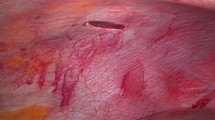Summary
BACKGROUND: The decision in favor of surgery or nonoperative conservative treatment in abdominal trauma requires a precise diagnosis that is not always possible with imaging techniques. As there is particular danger that an injury to the diaphragm or intestines be overlooked, the indications for exploratory laparotomy should be generous. Owing to this circumstance, however, up to 41% of exploratory laparotomies turn out to be nontherapeutic and could be, or could have been, avoided with laparoscopy. METHODS: A diagnostic laparoscopy with therapeutic option in blunt abdominal trauma should only be attempted in stable patients. Usually three trocars are used and the exploration of the abdomen is systematic, beginning with the right upper quadrant and continuing clockwise. Small lacerations of the intestines and mesentery can be detected and sutured endoscopically, as well as injuries to the diaphragm. Injuries to parenchymal organs are not a primary indication for laparoscopy, but they can be sealed with tissue adhesive and collagen tamponade to prevent further bleeding. RESULTS: Routine use of laparoscopy can achieve a sensitivity of 90–100% in abdominal trauma. This can reduce the number of unnecessary laparotomies and the related morbidity. CONCLUSIONS: Laparoscopy can be performed safely and effectively in stable patients with abdominal trauma. The most important advantages are reduction of morbidity, shortening of hospitalization and cost-effectiveness. In the future, new developments in laparoscopy equipment and the introduction of computer technology and robotic devices can be expected to have a decisive influence on the treatment of trauma patients.
Zusammenfassung
GRUNDLAGEN: Die Entscheidung zu operieren oder nicht operative konservative Therapie vorzunehmen bedarf einer exakten Diagnostik, welche mit bildgebenden Verfahren nicht immer möglich ist. Insbesondere bei Zwerchfell- und Darmverletzungen ist die Gefahr des Übersehens größer und daher wird die Indikation zu einer explorativen Laparotomie großzügig gestellt. Dieser Umstand führt jedoch in bis zu 41 % zu unnotwendigen nicht therapeutischen Operationen, welche durch den Einsatz der Laparoskopie vermieden bzw. vermindert werden könnten. METHODIK: Eine Laparoskopie zu diagnostischen Zwecken mit therapeutischer Option wird bei Patienten mit einem stumpfen Abdominaltrauma nur bei gegebener Kreislaufstabilität durchgeführt. Meist werden dazu drei Trokare verwendet, wobei die Exploration des Abdomens systematisch am rechten Oberbauch beginnend im Uhrzeigersinn vorgenommen wird. Kleine Lazerationen des Darmes und des Mesenteriums können mittels endoskopischer Nahttechnik laparoskopisch therapiert werden. Auch Zwerchfellverletzungen stellen eine wichtige diagnostische und therapeutische Option dar. Parenchymatöse Organverletzungen stellen keine primäre Indikation für eine Laparoskopie dar. Sie können jedoch zur Vorbeugung vor einer neuerlichen Blutung mittels Gewebeklebung und Kollagentamponade versiegelt werden. ERGEBNISSE: Bei routinemäßiger Verwendung der Laparoskopie auch beim Abdominaltrauma kann eine Sensitivität von 90 bis 100 % erzielt werden. Dadurch besteht die Möglichkeit, die Zahl der unnotwendigen Laparotomien und die damit zusammenhängende erhöhte Morbidität zu senken. SCHLUSSFOLGERUNGEN: Die Laparoskopie beim Abdominaltrauma kann bei kreislaufstabilen Patienten rasch und effektiv durchgeführt werden. Die Verminderung der Morbidität, Verkürzung des Krankenhausaufenthaltes und die verbesserte Volkswirtschaftlichkeit stellen die wichtigsten Vorteile dieser Technik dar. Neue Entwicklungen bei Laparoskopiegeräten, die Einführung der Computertechnologie und von Robotiksystemen können die Zukunft der Laparoskopie bei der Therapie der Traumapatienten entscheidend beeinflussen.
Similar content being viewed by others
Author information
Authors and Affiliations
Corresponding author
Rights and permissions
About this article
Cite this article
Uranüs, S. Laparoscopy in blunt abdominal trauma. Eur Surg 37, 33–36 (2005). https://doi.org/10.1007/s10353-004-0126-z
Received:
Accepted:
Issue Date:
DOI: https://doi.org/10.1007/s10353-004-0126-z



